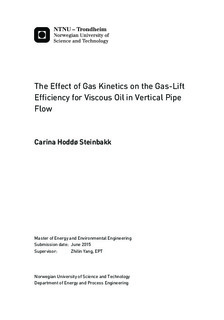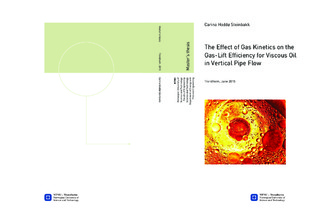| dc.description.abstract | For heavy oil, artificial lift can be applied to increase and stabilise production flow. How the gas kinetics, i.e. the lift-gas composition will influence this increase is the subject of this thesis and will be described in relation to multiphase flow, pressure drop and pressure-temperature-volume (PVT) -theory.
A vertical pipe flow was studied, simulating the pressure drop coupled with the accompanying multiphase flow and PVT-information. The simulations were run in MATLAB, supported by NeqSim, a non-equilibrium simulation tool. NeqSim was used to acquire the local fluid parameters in order to calculate the local pressure drop. To study the gas lift efficiency, four different simulation variations were performed. Different lift-gas compositions were applied to the reservoir to observe the response. The bubblepoint pressure was altered by adjusting the composition, the bottomhole flowing pressure (BHFP) was lowered by adjusting the reservoir pressure, and a pressure delay was applied to simulate solution above the bubblepoint pressure and a dissolution process below the bubblepoint pressure. Two different pressure delays were implemented; one with equal delay, another with different delays.
These simulations were run on a well system with a heavy oil composition and a set geometry. The boundary conditions were the inlet and outlet pressures, set by the reservoir pressure, 120 bar, and the separator pressure, 15 bar. This locks the BHFP at 105 bar, but it was also adjusted for one of the simulation variations. The varying parameter was the gas injection rate, which is set by a for-loop in the code and input flow rate found by using the bisection method for each simulation.
From running the simulations and analysing the results it has been found that gas lift has a generally positive effect on the deliverability and stability of an oil field, though with an exceeding amount of gas lift injection the friction pressure drop will have a negative effect on production. A denser gas seems to give an increased gas lift efficiency due to the higher solubility rate. This makes optimising the injection rate imperative in order to have the highest possible production efficiency. There is a higher efficiency for an undersaturated reservoir, though requiring an increased gas injection rate. As for the composition of the lift-gas, it will have an impact on efficiency and should be taken into account. An increased solution effect implemented by a pressure delay will have positive effect on the lift efficiency. A denser gas will dissolve at a higher rate into the liquid, decreasing the density of the wellbore column for higher gas injection rates than for the lighter gas. The delays occurring in a mass transfer situation between the phases will also influence the production, more so if the solution rate is higher than the dissolution rate, this should be studied further. | |

